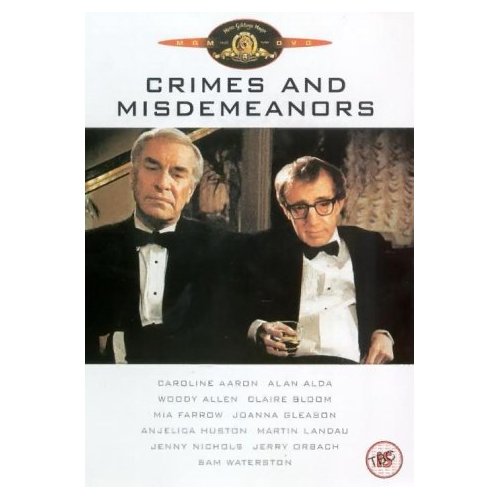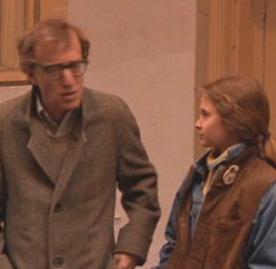What is a screenplay?
 This is always the first question I ask the students in the screenwriting
class I teach every fall. This is always the first question I ask the students in the screenwriting
class I teach every fall.
“It’s a story,” says someone, rolling their eyes
as if answering a dolt.
“It’s a blueprint," says another.
“No, man, it’s a lottery ticket,” pipes up the
reedy gent with the stud through his brow and Tarantino froth at
the mouth.
Nice try, my pretties. Above and below all else, a screenplay is
a puzzle.
Indeed, a screenplay is a devilish thing, not be entered into lightly
because the moment you strike the first key, you’re out into
the wilderness, playing with matches.
To illustrate my point, I show my class the first half of the film,
Adaptation. Why? Because, frankly, the first half is the
only part worth watching. Charles Kaufman is a clever guy, perhaps
too clever for his own good. As he (Nicholas Cage) frets and toils
over adapting Susan Orlean’s book, The Orchid Thief,
his ninny twin brother, Donald (also Cage) blithely embarks on building
a formulaic thriller from a mishmash of screenwriting cookbooks
by erstwhile gurus cashing in on the gold rush.
Kaufman makes two key albeit conflicted points about screenwriting.
Some material, larded with profound themes and delicate sentiments,
is impossible to translate to the screen. Second, you’ll never
know unless you try.
Adaptation is a cautionary tale about starting with high
ambitions and ending up in the cellar counting a fortune. The financial
imperatives of the industry compound the pressures inside the writer.
Donald triumphs because he solves his puzzle along the path of least
resistance and maximum return. Charlie flames out.
Then I show my class, Crimes and Misdemeanors, Woody Allen’s
last film of the 1980’s, a decade in which he had already
produced Hannah and Her Sisters, The Purple Rose of Cairo
and Broadway Danny Rose.
The film is the screenplay. That is to say that when you read the
script, you can see the film exactly as it rolls out on screen.
There are no special effects, or in the case of Scorcese’s
Casino, extended montages accompanied by elaborate voice-over
constructions manufactured in the editing suite.
Many people consider Syd Field, the venerable screenwriting guru,
a relic who long ago lost his relevance. The future belongs to Kaufman,
Tarantino and Bruckheimer. Sure, Field’s method is simple.
Deceptively simple. Any good screenplay has three acts, he cautions.
Character, plot and theme must work in harmony to lubricate and
drive the story through those three acts. There are no short cuts
to this goal. If the thing can’t get out of the gate smoothly
in the first thirty pages, it’s doomed.
 Crimes and Misdemeanors is a quintessential Syd Field film.
Allen deftly initiates parallel plots, both concerning infidelity.
Judah (Martin Landau), a successful eye doctor, is attempting to
end an affair with Delores (Angelica Huston), an emotionally hungry
stewardess who won’t let him go. She threatens to expose their
affair to his wife and his financial improprieties to the many charities
he leads. Meanwile, Clifford (Allen), an idealistic documentary
filmmaker, is working on a film about a philosophy professor who
espouses a hopeful interpretation of Kierkegaard. To pay for its
completion, Clifford takes on a vanity project profiling Lester
(Alan Alda), his brother-in-law, a pompous yet successful television
comedy writer. On set he meets a lovely producer, Halley (Mia Farrow),
who helps him forget his unhappy marriage to Lester’s joyless
sister. Crimes and Misdemeanors is a quintessential Syd Field film.
Allen deftly initiates parallel plots, both concerning infidelity.
Judah (Martin Landau), a successful eye doctor, is attempting to
end an affair with Delores (Angelica Huston), an emotionally hungry
stewardess who won’t let him go. She threatens to expose their
affair to his wife and his financial improprieties to the many charities
he leads. Meanwile, Clifford (Allen), an idealistic documentary
filmmaker, is working on a film about a philosophy professor who
espouses a hopeful interpretation of Kierkegaard. To pay for its
completion, Clifford takes on a vanity project profiling Lester
(Alan Alda), his brother-in-law, a pompous yet successful television
comedy writer. On set he meets a lovely producer, Halley (Mia Farrow),
who helps him forget his unhappy marriage to Lester’s joyless
sister.
The title of the film is apt: Judah’s adultery progresses
to murder; Clifford’s to regret and disappointment. Neither
story could stand without the other. The autumnal mood and Shakespearian
gravitas of Judah’s story finds balance in the hapless unrequited
love story of Clifford and Halley. The absurdity of life, the contingencies
of life offer both light and shadow.
Allen has always had a passion for Ingmar Bergman. He hitherto could
never create the right venue to pay homage to the heavy-hearted
Swede and his use of modern theatre techniques in cinema. Syd Field
warns against the dream sequence or the flashback. Anything that
stops the action is verboten. Yet Allen in Crimes and Misdemeanors
effortlessly utilizes the flashback and the dream sequence
to explore Judah’s haggard conscience as he enlists the help
of his gangster brother Jack to dispatch the harpie stewardess.
One sequence in particular I love. As Judah shambles through his
Westchester County pile during a midnight thunderstorm, we hear
a snippet of conversation from a previous scene. It is the voice
of Ben, a rabbi and a patient of Judah’s to whom Judah has
confessed his infidelity. Ben, suffering from a degenerative eye
condition, advises that Judah look to his religious upbringing for
moral clarity. Judah sits down in the living room, the embers still
burning in the fireplace. He lights a cigarette. Suddenly we feel
another presence in the room. It is Ben. “Can you really go
through with it,” he asks Judah. They have a deep, searching
chat about murder for hire that seems real but is in fact going
on inside Judah’s head. We see an important decision being
made in an inventive yet kinetic manner that progresses the plot
while amplifying the elemental moral dodginess of Judah. No special
effects, no fades or wipes, no Vaseline on the camera lens. Allen
trusts the reader and the viewer to do the work of enjoying his
trick.
A veteran
drama teacher once told me that you should never count on casting
to carry off your characters. If their voices and their motivations
aren’t clear on the page, you’re dealing yourself some
low cards. Crimes and Misdemeanors is flawlessly cast yet
when you read the script, you realize that the character of Judah
as written by Allen demands Martin Landau to stagger through the
film rattled and ragged -- a Brooklyn rabbi’s son grown into
a successful eye doctor unable to see his moral turpitude or take
responsibility for it.
 The
last sequence of the sequence takes place at the wedding of Ben’s
daughter. He is now completely blind. Judah has beaten the rap for
his murder of Delores. Clifford has discovered that Lester is engaged
to Halley. Allen closes with a montage of images from the film.
We hear the voice of Professor Levy, the philosopher who, we learned
earlier, has committed suicide. His words are lovely, gimlet-eyed
yet moving. But why Professor Levy? Here is a minor character whom
we only knew through his image on the screen of a movie editing
machine. Why should he get the last words in the script? Ah, but
wait. Throughout the film, Allen has used old movie clips to toggle
from Judah’s story into Clifford’s. These clips, including
Professor Levy’s, act as a Greek chorus, providing an omniscient,
knowing commentary upon the little people of the film. Why shouldn’t
Professor Levy have the last word. The
last sequence of the sequence takes place at the wedding of Ben’s
daughter. He is now completely blind. Judah has beaten the rap for
his murder of Delores. Clifford has discovered that Lester is engaged
to Halley. Allen closes with a montage of images from the film.
We hear the voice of Professor Levy, the philosopher who, we learned
earlier, has committed suicide. His words are lovely, gimlet-eyed
yet moving. But why Professor Levy? Here is a minor character whom
we only knew through his image on the screen of a movie editing
machine. Why should he get the last words in the script? Ah, but
wait. Throughout the film, Allen has used old movie clips to toggle
from Judah’s story into Clifford’s. These clips, including
Professor Levy’s, act as a Greek chorus, providing an omniscient,
knowing commentary upon the little people of the film. Why shouldn’t
Professor Levy have the last word.
Allen
was fifty three when he wrote this film. Crimes and Misdemeanors
examines people out in the middle of life’s sea where neither
shore is visible and the undertow is strong and treacherous. Screenwriting
students in their twenties might wonder how it is relevant to their
hyperactive cultural world. But if you read, say, the script for Pulp Fiction,
you can’t help but suspect that Tarantino jumps all around
in his narratives because there’s not much to them or his
characters. Moreover, because the characters never come to life
as anything more than ventriquilist dummies for the author’s
various obsessions, the audience is safe from any emotional involvement
or imposition. Nothing is at risk.
Crimes
and Misdemeanors is a puzzle brilliantly constructed and then
brilliantly solved. The reader is confronted with difficult characters,
difficult themes and plots that hardly adhere to the Hollywood model
of happy endings. It is a testament to the ecology of a good script.
--
Timothy Dugdale
Timothy Dugdale teaches in the Department of English at the
University of Detroit Mercy.
|






